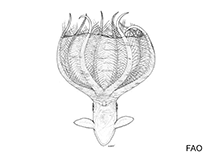Stauroteuthis syrtensis Verrill, 1879
Balloon octopod| Native range | All suitable habitat | Point map | Year 2050 |

|
| This map was computer-generated and has not yet been reviewed. |
| Stauroteuthis syrtensis AquaMaps Data sources: GBIF OBIS |
Upload your photos
Google image | No image available for this species;
drawing shows typical species in Stauroteuthidae.
Google image | No image available for this species;
drawing shows typical species in Stauroteuthidae.
Classification / Names Common names | Synonyms | CoL | ITIS | WoRMS
Cephalopoda | Octopoda | Stauroteuthidae
Environment: milieu / climate zone / depth range / distribution range Ecology
Pelagic; depth range 250 - 4000 m (Ref. 1978), usually 1500 - 2500 m (Ref. 1978). Polar; 3°C - 3°C (Ref. 1987)
Distribution Countries | FAO areas | Ecosystems | Occurrences | Introductions
Northern Atlantic. Subtropical to polar.
Length at first maturity / Size / Weight / Age
Maturity: Lm ? range ? - ? cm Max length : 11.4 cm ML male/unsexed; (Ref. 1978); 9 cm ML (female)
Lower depth from Ref. 1987. Known lengths are: total length, 50 cm; maximum unsexed mantle length, see value above (Ref. 96968), and male mantle length, 7.8 cm (Ref. 1978). Typically captured within about 100 m off the bottom. Bioluminescence has been reported from the sucker bases of this octopod (Ref. 96968).
Life cycle and mating behavior Maturity | Reproduction | Spawning | Eggs | Fecundity | Larvae
Members of the class Cephalopoda are gonochoric. Male and female adults usually die shortly after spawning and brooding, respectively. Mating behavior: Males perform various displays to attract potential females for copulation. During copulation, male grasp the female and inserts the hectocotylus into the female's mantle cavity where fertilization usually occurs. Life cycle: Embryos hatch into planktonic stage and live for some time before they grow larger and take up a benthic existence as adults.
Main reference
References | Coordinator | Collaborators
Collins, M.A. and C. Henriques. 2000. (Ref. 1978)
IUCN Red List Status (Ref. 130435: Version 2024-1)
Data deficient (DD) ; Date assessed: 01 July 2014
CITES status (Ref. 108899)
Not Evaluated
CMS (Ref. 116361)
Not Evaluated
Threat to humans
Human uses
| FishSource |
Tools
More information
Trophic Ecology
Ecology
Population dynamics
Growth
Age/Size
Length-weight
Length-length
Length-frequencies
Mass conversion
Recruitment
Abundance
Age/Size
Length-weight
Length-length
Length-frequencies
Mass conversion
Recruitment
Abundance
Life cycle
Distribution
Human Related
Aquaculture profile
Stamps, Coins Misc.
Stamps, Coins Misc.
Outreach
Taxonomy
References
Internet sources
BHL | BOLD Systems | CISTI | DiscoverLife | FAO(Publication : search) | Fishipedia | GenBank (genome, nucleotide) | GloBI | Gomexsi | Google Books | Google Scholar | Google | PubMed | Tree of Life | Wikipedia (Go, Search) | Zoological Record
Estimates based on models
Preferred temperature
(Ref. 115969): 2.7 - 4.3, mean 3.3 (based on 761 cells).
Price category
(Ref. 80766):
Unknown.



